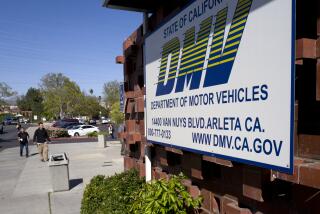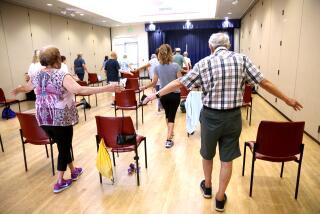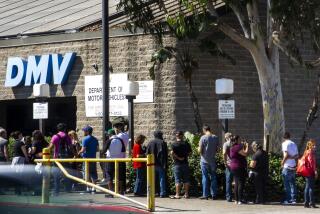How to have ‘the talk’
David Solie thought he was being a good son and a competent manager. But his strong-willed mother was having none of it.
Carol Solie, 72, had been caring for herself, her 28-year-old son, Roger, who has Down syndrome, and the family home in Portland, Ore., since her husband died in 1989. From David Solie’s vantage point in Calabasas, it was too much. So once a month, he would travel nearly 1,000 miles north to set things right.
This son decreed that his mother should move someplace easier to navigate -- an assisted living complex, perhaps. She should relinquish her role as chief caregiver to Roger, who could be placed in a group home. David Solie insisted on looking over his mother’s finances. He also had some thoughts on what kind of car she should be driving.
After fending him off for a year, the indomitable Carol Solie sent her imperious son packing and stopped talking to him for almost three years. And so David Solie, who had cared for hundreds of elderly patients as a physician’s assistant, was left to ponder the mistakes that resulted in his abject failure to communicate with his own mother.
The nation’s 77 million baby boomers are not the first adults to care for their aging parents. But they are the first generation to care for parents who are living longer but with more chronic medical conditions -- and often far from their grown children.
More than 43 million Americans provide care for someone older than 50 who is aging or disabled, including 15 million who care for someone with Alzheimer’s disease or dementia. Nearly 1 in 10 women ages 45 to 56 is a member of the “sandwich generation,” taking care of an aging parent and her own children at the same time, according to a 2006 report from the Department of Labor.
For each of these grown children, there are moments when an aging loved one’s safety seems to depend on that caregiver’s ability to coax, cajole, persuade or coerce Mom or Dad to make changes in the interest of his or her health and safety -- changes that almost uniformly prompt resistance.
The caregiver’s aim may vary -- to persuade a parent to turn over the financial reins, see a doctor, accept help with cooking or bathing, or give up those potent symbols of adult independence, the car keys. How persuasive he or she is may well determine whether car accidents, hip fractures, house fires and destitution will be averted.
Yet there is no accepted script for how this crucial conversation should go.
“In a generation or two it will seem normal and we should have it figured out,” says Elizabeth Dugan, a professor of gerontology at the University of Massachusetts in Boston and an expert on aging and driving performance. “But for now, it is challenging, rewarding, exhausting and more.”
--
Different agendas
David Solie was finding his way, fitfully. In his medical training, he learned about the many stages of childhood development and the physical ailments that come late in life. But his training had neglected to teach him that aging too has its developmental demands.
His elderly mother’s psychological needs were certainly different from his own. In his busy life, efficiency was key, he says. But he came to recognize that “efficiency was not on my mom’s agenda.”
What was on Carol Solie’s agenda -- as with most aging parents at the threshold of needing their children’s’ help -- were two things, her son says. She had a powerful need to maintain control over her life at a time when age and illness were making that increasingly complex. And she nurtured a deep desire to see and appreciate that her life had meant something -- to consolidate her legacy.
When David Solie acknowledged those needs, he naturally “softened the reins,” he says. He also softened his heart, asking his mom questions about her life and listening intently to her stories. Acknowledging to his mother that there were no longer easy ways to reconcile her safety and her desire to stay put, he asked what would work for her. Then mother and son struck compromises that built a network of support around her and Roger in their home.
If David hadn’t recognized the powerful forces driving his mother, he concluded, his efforts to look after her would have been doomed.
“We arrive with the best intentions,” says Solie, who gathered his insights into a book called “How to Say It to Seniors: Closing the Communication Gap with Our Elders.” “We think, ‘They’re older, they don’t get it. They’re wrong and I’m right.’ But right’s not relevant.”
Of all the excruciating conversations a caregiver will ever initiate with an aging parent, the “driving talk” is perhaps the worst. A loved one who has enjoyed all the rights, privileges and responsibilities of adulthood will not cede his or her independence and autonomy happily, nor perhaps willingly.
Fear silences many grown children from having these conversations until it is too late for negotiation, experts say. And that may suit aging parents: According to a 2004 study conducted by the Hartford Financial Services Group Inc. and MIT’s AgeLab, half of older drivers who are still married would rather hear about driving concerns from a spouse. In addition, more than 4 in 10 older drivers living alone would prefer to have these concerns raised by their physician, as would a third of such drivers who are married.
Having “the talk” with a son or daughter consistently came in last. When they did have those talks with their kids, older drivers tended to prefer to hear it from children who live close by and are more in tune with their driving habits.
David Barg, who edits a magazine and website devoted to caregivers, calls the talk about car keys “caregiver kryptonite.” It can stay the tongue of even the most assertive child or render him powerless in the face of a cornered, furious parent clinging to his freedom and dignity.
That’s probably just as well, Barg says. “If you walk in cold and say, ‘Give me your keys,’ you’re not just saying, ‘I want you off the road.’ You’re saying, ‘I want to infantilize you. I want to take away your independence. I am in control.’ And that is not the conversation you want to have.”
Ideally, says gerontologist Dugan, the “driving talk” is not one conversation but a series of them, begun well before there are unexplained dings on the car, tickets in the mail or an accident. This can take some of the pressure off of adult children. “It isn’t a one-shot deal,” she says.
A near-miss might spark a discussion -- or even better, an admission by the older driver of some minor trouble on the road, like getting lost on the way home or being honked at by impatient drivers.
What many caregivers don’t account for is that “many times, our loved ones already know” that they are not as competent behind the wheel as they used to be, Barg says. They are uncomfortable driving on highways, fearful of driving at night and confused by dense traffic and have begun to scale back their driving accordingly. That’s when an attentive caregiver can take the first steps to easing an older driver into the passenger seat.
The initial conversations should acknowledge the measures that an older adult has already taken to stay safe, experts say. Then the caregiver can step in with well-researched options for alternate transport and assure an elderly driver that his ability to see friends, get to the doctor and continue with other activities around town is a priority. Later, after the car has sat unused for several months, a caregiver can tally the cost of keeping the vehicle insured and registered and show a parent how much taxi fare or bus service that money could buy.
At the same time, Solie says, it’s appropriate to “draw a line in the sand” that makes clear what the stakes are.
“We tell our parents, ‘None of us can burn the house down, and we can’t kill people driving,’” he says. If parents insist on living on their own, they’ll have to compromise for the sake of safety: “We all have the same laws of the universe operating over us.’”
--
Working together
Many baby boomers make the mistake of thinking of their new responsibilities as a role reversal. But that’s not only wrong, Solie says, it’s a formula for failure.
“We’re not parenting our parents, we’re partnering with our parents, “ he says. “You tell them, ‘I think you want to have as much independence as possible, and my job is to help you weigh both sides.’”
For adult children like Solie who try to muscle their way into the caregiver role, that sometimes means slowing down and apologizing. “There’s nothing wrong with going back and saying, ‘I was wrong. This is your life, and you’re in control.’”
That admission can produce a sudden thaw, he has found: “Mom or Dad says, ‘I don’t have to fight this kid for control. This kid speaks to me with respect.’ And they come alongside.”
--
More to Read
Sign up for Essential California
The most important California stories and recommendations in your inbox every morning.
You may occasionally receive promotional content from the Los Angeles Times.











